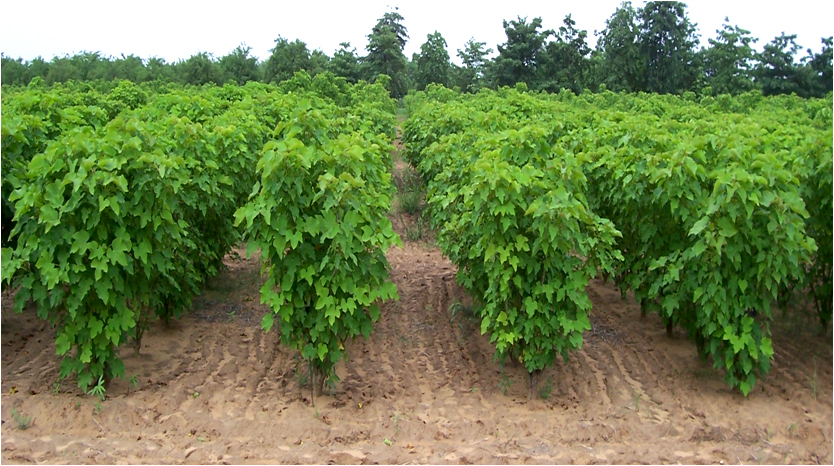JATROPHA (Jatropha curcas)

Origin and Distribution in the world
Abundance and availability of energy resources largely determine the economic well being of a country. Self reliance in energy is vital for the economic development of any nation and India is no exception to this fact. Major portion of our valuable foreign exchange reserve is spent on meeting the import bill of petroleum products.
Jatropha curcas commonly called ‘‘Ratanjot’’ in Hindi, ‘‘Kattamanakku’’ in Tamil is a multi purpose shrub of significant economic importance as Biofuel.It adapts well to semi arid marginal lands to fertile lands and as well as live fence ,as it is not browsed. The crop is particularly suitable for garden land situations where the irrigation intensity is low. Besides, this crop may not replace other important food crops and in turn will not have a major impact on cropping pattern.
Origin
Native to Central America and Mexico
Distribution
1. Jatropha curcas
Jatropha curcas is a tropical shrub native to Mexico and Central America, but is widely distributed in wild or semi cultivated stands in Latin America, Africa, India and South East Asia. In India, Portuguese navigator introduced in it in the 16th century. It occurs in almost all parts of India including Andaman island and generally grown as live fence.
2. Jatropha intergerrima
3. Jatropha gossypifolia
Jatropha gossypifolia is native to Brazil found in waste lands, forests and gardens.
4. Jatropha glandulifera
It is known as Adalai in Tamil distributed in Chengalpattu, Coimbatore, Dharmapuri, Pudukottai, Ramanathapuram, SouthArcot, Trichy and Tirunelveli.
5. Jatropha maheswari
Distributed in Kanyakumari and Tirunelveli districts.
6. Jatropha multifida
It is known as malai amanakku in Tamil. Its native is America.
7. Jatropha tanjorensis
Distributed in Tanjore, Trichirapalli, Kancheepuram, Tiruvellore, Coimbatore, Dharmapuri, SouthArcot and Ramanathapuram
8. Jatropha villosa var.villosa
It is known as thanakku in Tamil, a shrub distributed in Coimbatore, Dharmapuri, Salem and the Nilgiris.
9. Jatropha villosa var. Ramanadensis
It is a shrub distributed in Ramanathapuram in Tamil Nadu.
10. Jatropha podagrica
A small shrub with a curious gouty stem, large peltate leaves and small bright red flowers,a native to New Granada.
11. Jatropha nana.
Jatropha curcas grows on a wide range of climate and soils. This tree can be established on degraded, gravelly, sandy or saline soils with low nutrient content. The distribution of Jatropha curcas shows that its introduction has been most successful in drier regions of the tropics with an average annual rainfall between 300 and 100mm.however, it grows well in areas with higher rainfall. As Jatropha curcas occurs mainly at lower altitudes (0-500mm).It is non sensitive to day length. being a species of arid and semi arid tropics, it survives on areas receiving very low rainfall.however,it does well even in slightly cool conditions and can withstand and a light frost.Jatropha curcas is highly adaptable species , but its strength as a crop comes from its ability to grow on poor and dry sites.
Jatropha adapt itself in various agro climatic conditions. It can withstand drought to a greater extent and frost to some extend, but not to a prolonged period. Older the tree, better the withstanding capacity to the extreme climates. Severe cold and frost kills the younger plants and damage the older plants. The optimum temperature is 30-400C. However, it can establish its growth both in high and low temperatures. Highly adapted to tropical and subtropical climates. Bright sunlight is essential for flowering, photosynthesis and seed maturity. It can grow well from 600 mm of rain fall onwards as rainfed crop, but it establishes its growth from 230 mm up to 2000mm. A well distributed rainfall of 600-800mm is highly suitable for this crop. The establishment of the plant is observed up to 500m MSL.
Botanical description of Jatropha
Jatropha curcus belongs to the family Euphorbiaceae. The genus Jatropha has 176 species and distributed throughout the old.among them 12 species are recorded in India. India.11 species of Jatropha available in the germplasm of Tamil Nadu Agricultural University. They are
- Jatropha curcas
- Jatropha integerrima
- Jatropha multifida
- Jatropha maheswari
- Jatropha gossypifolia
- Jatropha podagrica
- Jatropha tanjorensis
- Jatropha villosa var ramnadensis
- Jatropha villosa
- Jatropha nana
The species Jatropha curcas is promising one with economic seed yield and oil recovery. The oil from Jatropha curcas can be used as biodiesel blend up to 20%. Jatropha is deciduous soft wooded small multipurpose small tree or shrub. it usually attain the height of 3-5m,however it can grow even up to 8-10m in favorable conditions. After the blending of Jatropha oil its cake used as natural manure. Villagers grow this species as live fence. The crop can be maintained 30-40 years economically.this crop grow well in tropical and sub tropical regions.
Jatropha curcas is a tropical shrub native to Mexico and central America,but it is widely distributed in wild or semi cultivated stands in Latin America,Africa,India and South East Asia.In India Portuguese navigator introduced it in the 16th century. It is drought resistance and this can be grown on waste lands.
Leaves
The leaves are usually simple deeply palmately 3-5 lobed. The stipules are usually represented by ciliate glands.the venation is palmate.the leaves are green to pale green broad and glaborous.
Inflorescence
The inflorescence is complex.the first branching is recemose and subsequent branching are cymose.Inflorescence are formed terminally or axillary,with female flowers usually slightly larger.it is formed in the leaf axil small yellowish green flowers are born in loose panicles of cymes.
Fruits
After pollination fruit is usually a three chambered formed and schizocarpic capsule splitting in to three one seeded cocci.the seeds are often with conspicuous caruncle.Seeds resemble castor in seed in shape ,ovoid, oblong and black in colour.The seeds become mature when the capsules from green to yellow, after two to four months after fertilization. |

